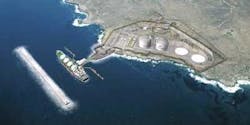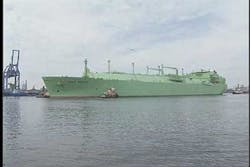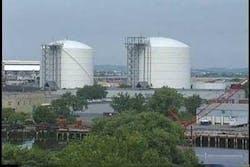Financing LNG terminals
null
At a recent conference on liquefied natural gas (LNG) imports to North America, a Credit Suisse First Boston managing director, Steven Greenwald, sat on a panel discussing prospective financing for the massive coastal or offshore facilities when he was asked if LNG terminals were the “next wave” of energy project financing in this part of the world. Greenwald, who has a ready sense of humor, laughs about the experience in re-telling it now.
“That was a high, easy pitch you could hit out of the park,” he recalled. “The answer is, ‘Of course not’. The number of LNG terminals that will ultimately get built in the next several years you can probably count on one hand.” (The industry consensus in late 2004 appears to be six to 10 terminals.)
For investment bankers like Greenwald, as well as attorneys and CPAs who toil in the energy space, the prospect of up to 30 dots on a map of North America representing potential new or expanded LNG terminals on one of the coasts - East, West or Gulf - tends to push a collective enthusiasm button, not unlike what happened 10 years ago at the dawn of electric industry restructuring when merchant generation plants were the hot infrastructure items.
There are two basic financing options for third-party funds - tolling, or capacity agreements, and integrated merchant structures - with many variations in between. So far, the deals farthest along in development are those structured like the Sempra Energy-Royal Dutch/Shell receiving terminal at Costa Azul, on Mexico’s Baja Peninsula. This project will be entirely self-financed by the two major companies.
While the first new significant shipments of LNG into North America are still three years away at the earliest, the financial hyperbole appears to be arriving sooner. The proposed projects still have many obstacles to overcome.
The Gulf of Mexico is the easiest of the three coasts on which to site an LNG facility because of its concentration of pipeline, storage and processing facilities, but some insiders point out that even in and around the Gulf, potential gas quality/gas processing issues could be “show-stoppers,” as one Houston-based attorney specializing in LNG speculated.
“Most issues can be overcome, but so far nothing has gotten financed, and that is really the lesson so far,” said Greenwald, a senior member of CSFB’s global energy/project finance group, who noted that it has been 21⁄2 years since the LNG push began.
“The truth is that very few things have gotten permitted,” he said. “You have to put the horse before the cart. We’re not in the financing stage yet - we’re in the advisory stage. No one is involved in financing right now.”
In the financing stage, with regulatory permits and supply contracts in hand, the different options split between investment-grade companies, which constitute nearly everybody in the sector now, and those who are not. Greenwald said investment-grade parties have the option of a short-term bank deal and doing long-term refinancing later, or doing a long-term bond deal at the outset. Non-investment-grade players and firms with tolling contracts for short-term five- to eight-year periods have only the option of “term-loan B-market” financing or high-yield junk bonds.
A North American survey released in August turned up as many as 40 LNG receiving terminal proposals, five of which had been cancelled by the time the survey was completed. Criteria for project success, as applied by the survey team, include: the sponsors’ “financial strength and credibility,” followed by their access to LNG supplies, and finally the degree of local opposition to the plant site. (Safety concerns, fueled by studies and Congressional rhetoric, are a growing factor, both before and after the permitting process.)
Among the 30-odd proposals to build or expand receiving terminals, the survey concluded that about $15 billion in capital investment ($500-$750 million per terminal) would be needed collectively for construction costs. If the full value chain from the foreign gas fields to the burner tip of the end-user is considered, total capital outlay for a project may be 10 times as much.
“The magnitude of this (potential) investment is too great to undertake projects on a purely ‘merchant’ basis, which introduces into the natural gas business a much stronger imperative for long-term contracts than in the past,” according to the surveys for the “North American Terminal Survey,” completed in August 2004 by Pan EurAsian Enterprises.
Potential financing sources run the gamut from traditional sponsor equity, public debt/equity markets, and bank lending to less traditional sources, such as multi-tranche financing with debt capital markets and commercial loan combinations. The non-traditional can also include municipal (tax exempt) financing, such as development bonds and revenue bonds, or monetizations/receivables financings, according to Dan Rogers, an attorney with Chadbourne & Parke’s Houston office, which specializes in LNG financings.
Rogers also sees what he calls “multilateral/bilateral and export credit agency financing,” along with “Islamic financing” as potential sources of funding for the terminals that are expected to come on line in the next five or six years. Chadbourne is one of about a half dozen law firms active in the international energy projects field. It represents lenders, developers and capacity users at seven proposed North American LNG import terminals.
Most recently, the fully-permitted North Baja receiving terminal on the Pacific Coast of Mexico near Ensenada, being developed by affiliates of San Diego-based Sempra Energy and Shell, lined up its one billion-cubic-feet-per-day (cf/d) of supplies and its commitment to self-financing the $600 million facility.
Shell and Sempra have two elements that are absolutely essential for third-party financing: 1) clear regulatory permits for beginning construction of the terminal; and 2) long-term gas supply cotracts. In Shell’s case, half of the terminal’s capacitywill go to its own supplies from its Sakhalin II project in eastern Russia in which Shell is the largestshareholder.
A year ago, Shell and Sempra announced a 50/50 “developmental partnership” in getting its Costa Azul site ready for construction of a receiving terminal. However, in mid-October, the two parties changed the deal based on a 20-year capacity agreement (similar to tolling) for Shell’s LNG supplies and Sempra’s subsidiary, Sempra Energy LNG, building, owning and operating the terminal.
Just days before this new agreement was made public, Sempra announced signing a 20-year supply contract with BP Indonesia and its affiliates in the Tangguh LNG Project, which include the Indonesian government and several major Japanese companies.
Mitsubishi Corporation, which previously had proposed its own LNG receiving terminal at Long Beach harbor, in the greater Los Angeles area, is one of the investors in the supply/production end of the Indonesian LNG project. Mitsubishi has not revealed whether or not it still intends to pursue the Long Beach project, which has been opposed by a number of community and environmental activist groups.
“We have worked cooperatively with Shell to develop this project over the past several months,” said Donald Felsinger, Sempra president and COO. “We jointly determined that the consolidation of the ownership, construction and operation of the project [by Sempra] and Shell’s capacity agreement represent a mutually beneficial commercial arrangement for both companies.” In this case, both Shell and Sempra are responsible for lining up long-term sales contracts for their respective 500 million cf/d gas supplies in Mexico and the Southwest United States.
The Shell-Sempra deal follows the “integrated” financing model for an LNG facility, which is thought to be the province of the “super-major” global oil and gas companies, according to Chadbourne’s Rogers, who urges LNG project proponents to bring in financial experts “early enough to optimize commercial arrangements” that ultimately will impact the project’s financing terms and will help to avoid pitfalls when the facility is ready to be financed.
“Financing will be available for well-structured [his emphasis] North American LNG terminal projects,” Rogers said. “The industry will need new templates for LNG terminal finance and cannot follow the original model or simply extrapolate the upstream finance model.”
A Standard & Poor’s report last fall by Peter Rigby, “Hot Prospects for a Cold Fuel: Project Finance Seeks the LNG Terminal Business,” is blunt about the multitude of project risks that need to be addressed to obtain financing on reasonable terms.
“In addition to the counterparty credit risk that tollers, integrated project affiliates, or regulators impose, LNG terminal projects will have to satisfy lenders that local opposition and other political risks will not interrupt construction or delay commercial operations,” Rigby wrote. “Those risks have delayed or ended the hopes of many LNG projects in the US and may ultimately delay LNG’s entry into the US unless regulators and politicians at the state and federal level seek a solution.”
However, CSFB’s Greenwald, who helped put together Panhandle Energy’s $305 million Lake Charles, Louisiana, LNG facility refinancing, thinks there is nothing “specifically unique” to LNG facilities that would make them hard to finance. With permits and supply agreements in hand, he thinks the financing is no different than project financing a new interstate pipeline. The refinancing for Panhandle, Greenwald said, was “quite fine” with the only noticeable “speed bump” being the timing of going to market with the financing the same week that Enron Corporation filed for Chapter 11 bankruptcy protection in early December 2001.
Global energy companies seeking to build an LNG terminal will likely self finance, said Greenwald, who added that later on, after the facilities are operating successfully and generating steady revenue flow, even the major players may choose to refinance. Chadbourne’s Rogers also thinks that is a likely scenario.
Whether balance-sheet financed, refinanced or done through some form of third-party project financing (the latter meaning a loan made to a single-purpose borrower with repayment coming from one revenue-generating asset, and limited or no recourse to the sponsors), the upfront project structuring and risk analysis are critical to the ultimate viability of the financing. Political risk, currency risk and financing risk are interwoven, and must be assessed and accounted for in any comprehensive financing package.
Financing is less complicated when the prospective owner/operator of the LNG terminal has a 20-year tolling agreement for the bulk of the terminal’s capacity, so the risks upstream and downstream are borne by other parties. However, when the terminal operator also wants to buy chunks of the plant’s throughput and then has to market them on the downstream side, financing gets more challenging, according to the experts, because the borrowers are exposed to the risk of LNG price and volume fluctuations that are not an issue in a straight tolling facility.
The non-tolling deals are more complex and more akin to a merchant power plant deal, but as a gas project, with the advantage of storage that is not available in the electricity sector, the risks of a so-called “integrated,” or “merchant,” terminal are different.
“The two biggest issues are 1) price and volume risk exposure - who wears it, and if it is the borrower, how do we figure out a way to mitigate it, and 2) credit risk,” said Rogers. “If the borrower is trading his own LNG, you have all sorts of associated credit issues. Not only does the borrower have to supply credit upstream to the LNG producers, and in some cases, transporters, but the borrower also has to provide security for its downstream sales.
“The credit issue is the second of the two most significant issues,” added Rogers. “With a pure tolling facility, you are just analyzing the credit of the throughput capacity holders. But there can be issues with some of them and their credit and how they are credited to make sure the banks are lending to basically investment-grade-rated revenue streams.”
In looking for financing models, tolling terminals need look no further than power plants. But for the integrated or merchant facilities, there are no easily accessible models. For those projects, it is a case-by-case situation, according to some of the potential lenders, such as CSFB, Lehman Brothers, Citigroup and Royal Bank of Scotland.
For integrated merchant LNG import terminals, Rogers is not sure there is any model. He stresses this has to be looked at on a case-by-case basis. Key questions are: Where is the LNG coming from? What are the pricing arrangements? Who is arranging for transportation and bearing those risks?
“There are so many variables in the merchant project, I am not sure there are any models. Those are all custom-tailored solutions,” Rogers said.
Are engineering and operations more intertwined with financing in LNG projects than other energy projects of the same magnitude?
“It is critical on all LNG projects today because there is less understanding of the industry in North America, as evidenced by growing concerns about the safety and vulnerability of LNG ships when docked,” said Rogers. “People are still getting their hands around the different types of vaporizer technology, or storage and containment issues, and there is new technology being proposed out there. So I think there is more focus on having high-quality engineering on projects like this, compared with a power plant or a pipeline.”
Lenders - not just community activists - are watching these aspects closely.ogfj
The author
Los Angeles-based OGFJ correspondent Richard Nemec has been following the resurgence of LNG the past three years. He spent more than 20 years with SouthernCalifornia Gas Company and its parent company, now Sempra Energy, and served as head of corporate and financial communications. Nemec has a master’s degree in journalism from Northwestern University, Evanston, Illinois.



